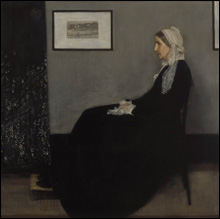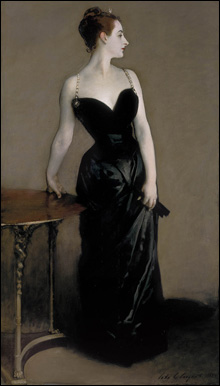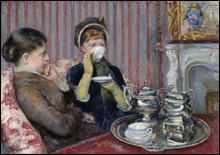
ARRANGEMENT IN GREY AND BLACK, #1: PORTRAIT OF THE ARTIST’S MOTHER: An icon that requires reverence, it’s nonetheless as dull as you’d expect. |
Thomas Eakins was one of thousands of ambitious young American artists who flocked to Paris after the Civil War. They went to learn from the great French Académie des Beaux-Arts (the original Academic art) and its official Salons. “What I have learned I could not have learned at home, for beginning Paris is the best place,” the 25-year-old Eakins wrote home to his father in 1869.But they arrived just as the Academy’s pre-eminence was being undermined by Édouard Manet and the Impressionists. They witnessed the birth of European Modernism, but most were too square to realize it. The more than 100 works by 37 artists in the Museum of Fine Arts’ new blockbuster, “Americans in Paris: 1860–1900,” offers some great and important paintings — John Singer Sargent’s Madame X, James McNeill Whistler’s Mother, a raft of Mary Cassatts. But that missed opportunity is the story underlying this show, which was organized with London’s National Gallery and New York’s Metropolitan Museum of Art.
In the mid 19th century, a rapidly growing Paris became the capital of European art and fashion, attracting artists from Scandinavia, New Zealand, Japan. Americans went to copy at the Louvre and study the rigorous academic ways at Paris’s national art school and private studios, which were considered the finest in the West. Eakins studied with a French academic artist so devoted to visual truth that he nailed a cadaver to a cross to study when painting a Crucifixion. Bouguereau and Cabanel reached cornball heights mixing realism and myth to produce photographic pin-up Venuses absurdly lounging atop waves.

MADAME X: The show mostly tells the story of what American artists didn’t learn. |
Americans hoped to make their names by winning spots among the hundreds of paintings crammed into the annual Salons, the top art marketplace. About a third of the Americans were women. They found entry into schools and freedom from both American and French customs as outsiders in Paris. Many Americans wound up broke, homesick, lonely, and pathetically unable to speak the language. They clustered together, keeping American customs, and, as immigrants often do, annoyed nativist sensibilities.Paris must have seemed an escape during the Civil War. Whistler, among the first to go, studied in Paris in the 1850s and missed the war, but some say his mother joined him in London in 1863 to avoid the conflict. Eakins, who bought his way out of Union service, Winslow Homer, who spent much of the war as a Union combat illustrator for Harper’s Weekly, and Cassatt all arrived in Paris within 18 months of the war’s end. In 1867, future Sargent model Virginie Avegno (Madame X), who’d lost her father (he fought for the Confederacy), left an uncertain post-war Louisiana for Paris, where she met and married the rich French banker Pierre Gautreau. The end of the war freed up American wealth and spawned industrial tycoons. This meant more money for art, and it fostered museums like Boston’s MFA and the Met in New York, both founded in 1870.
Strolling through room after room of academic portraits, genre scenes, Paris gardens, and French countryside at the MFA, you begin to wonder how anyone escaped the academy’s conservative pull. Back home in Philadelphia, Eakins embraced the rigor of his academic teachers, elaborately mapping out compositions, analyzing models, and taking photographs to guide his paintings. Homer was enamored of the vigor of mid-19th-century French realists before he arrived for his 11-month Paris visit. Over his career, he shed the stagy stiffness of his Civil War work and grew increasingly fluid and vital. Is this the academic influence?
Sargent’s ravishing 1883-’84 Madame X looks terrific here. He chisels Gautreau’s sharp profile out of the brown background. She’s all alabaster skin — bare arms and lots of chest — overflowing a wasp-waisted black dress. The painting caused a scandal at the 1884 Salon, ruining Madame Gautreau socially and sending Sargent’s Paris portrait commissions into a tailspin. Parisians resented these American interlopers besting their homegrown painters and beauties. And unlike the idealized mythological nudes popular in the Salons, she’s a real hot woman. In the original version, the right strap of her gown had fallen down her arm; that detail was repainted and the strap repositioned.

THE TEA: Mary Cassatt’s style recalls her French pal Edgar Degas, but most other American artists didn’t get Impressionism. |
Sargent regrouped by dabbling in Impressionism, but these paintings look like copies of Impressionist paintings rather than the real thing. His talent is as a preternaturally dashing academic, laying down one perfect brushstroke after another without ever breaking a sweat. Painters like Eakins reveal their artistic struggle with every mark, but Sargent makes it look as if he never had to think. Soon he fled to England, where his portraits found great success.Now please genuflect before Whistler’s Mother. An icon that demands reverence, it’s nonetheless as dull as you’d expect. The balanced arrangement of shapes demonstrates how thoroughly Whistler had digested Japanese design, the hottest thing in Europe then. Your time will be better spent with his 1865 shoreline scene Harmony in Blue and Silver: Trouville, where sky, sea, and beach become delicate horizontal stripes and a white dash is a sailboat. Whistler went to Trouville with his mentor Gustave Courbet, but there he ditched Courbet’s meaty realism for wispy veils of color that push Japanese simplicity just shy of complete abstraction. It’s an Impressionist road not taken.